It’s been a long time coming with an unusually cold, dry spring but finally the plethora of wildflowers that adorn our verges and woodlands have started to show their faces. And not a moment too soon! Over on the other side of the pond, this week is National Wildflower Week and whilst it may not be a marked occasion for us here in the UK, I couldn’t resist taking the opportunity to ask my colleagues for their five favourite wildflowers. Fail me they did not and without further ado, here’s some fantastic specimens for you and the smaller people in your life to spot this May.
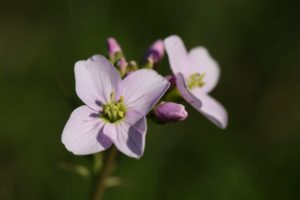 Lady’s Smock (Cardamine pratensis)
Lady’s Smock (Cardamine pratensis)
Also known as Cuckoo Flower or Milkmaids, this beautiful flower is edible and an important food source for rare butterflies on Exmoor. Found in meadows, along the edges of ponds and streams and in wet grasslands, this specimen flowers around the same time that the cuckoo’s start to call (hence one of its names). It’s young leaves have a similar peppery taste to cress or rocket and can be used in salads and sandwiches (although as always, please don’t eat anything unless you’re completely sure of what it is – usually best to be with someone who can positively ID it for you – better safe than…the alternative!)
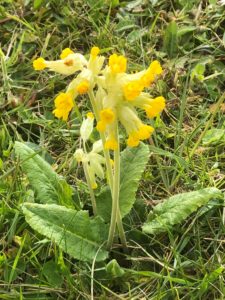 Cowslips (primula veris)
Cowslips (primula veris)
This cheery flower can be seen all over the place at this time of year, in woodlands, meadows, alongside the roadside and basically any place where it’s safe from grazing animals! Historically once much more prevalent, the cowslip is making a comeback and starting to return in droves after declining for a time due to modern farming techniques and the increased use of pesticides. Featured in two of Shakespeare’s works, this flower is well loved and was often associated with May Day in English traditions. Another fantastic herbal remedy, the flowers have been used for headache and insomnia remedies as well as making tasty wine (although perhaps the latter wouldn’t help with the headaches!)
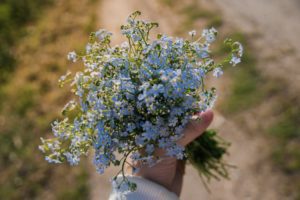 Forget-Me-Not (myosotis scorpioides)
Forget-Me-Not (myosotis scorpioides)
These distinctive tiny blue flowers have many a tale bearing to the origins of the name. My favourite is that a prince was picking flowers for his beloved alongside a river, and lost his footing, falling to his watery grave. As he fell, he shouted ‘forget me not’! Whether true or not, it’s an easy way to remember that they like to grow near water from May through most of the summer. These flowers are also edible although I’ve yet to try them – some of my research suggested they’d be well used as cake decorations or in ice cubes as well as in salads.
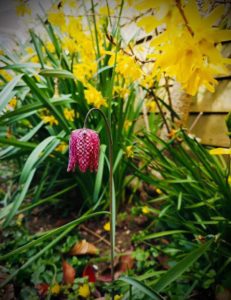 Snake’s-head Fritillary (fritillaria meleagris)
Snake’s-head Fritillary (fritillaria meleagris)
I stumbled across this flower in a friend’s garden just a few weeks ago and was absolutely captivated by it! This absolute beauty is named as it apparently looks like a snake’s head (although I’m not convinced) and unfortunately it is classed as a vulnerable plant as our loss of meadows is reducing it’s available habitat. It is a particular friend to our pollinators so is an important one to try and preserve. Luckily, a lot of conservation charities are on the case with this one but apparently it’s easy to grow despite being wild so maybe worth having a go and helping to keep the species alive?
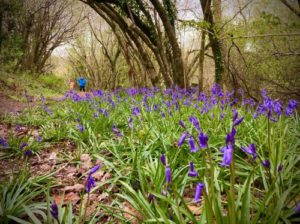 Bluebell (Hyacinthoides non-scripta)
Bluebell (Hyacinthoides non-scripta)
I was planning on talking about Figwort for our final flower, a new one to me and rather fascinating to read about. But…I felt that I couldn’t write about our favourite flowers without talking about the iconic bluebell. Scattered around the South West are woodlands that are famous for their bluebell displays in the Spring and we were delighted to visit our new Ilfracombe site this week to find this gorgeous sight! These flowers are steeped in folklore and legend, usually involving fairies and their cheeky endeavours. According to the Woodland Trust ‘It is said that if you hear a bluebell ring, you will be visited by a bad fairy, and will die not long after. If you are to pick a bluebell, many believe you will be led astray by fairies, wandering lost forevermore.’ – now there’s a good incentive to not pick them and leave them for others and the bees to enjoy!
We’d love to hear from you and find out how many of our favourite flowers you spot whilst out on your adventures – or perhaps you’ve got a favourite flower of your own that you think should have made the list? Don’t be a stranger, get in touch!
Author: Hannah Durdin, Content Whizz & Forest School Leader Date: Wednesday 3rd May
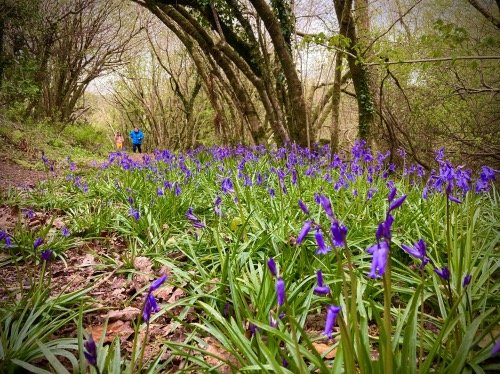
 Lady’s Smock (Cardamine pratensis)
Lady’s Smock (Cardamine pratensis)  Cowslips (primula veris)
Cowslips (primula veris)  Forget-Me-Not (myosotis scorpioides)
Forget-Me-Not (myosotis scorpioides) Snake’s-head Fritillary (fritillaria meleagris)
Snake’s-head Fritillary (fritillaria meleagris) Bluebell (Hyacinthoides non-scripta)
Bluebell (Hyacinthoides non-scripta)






